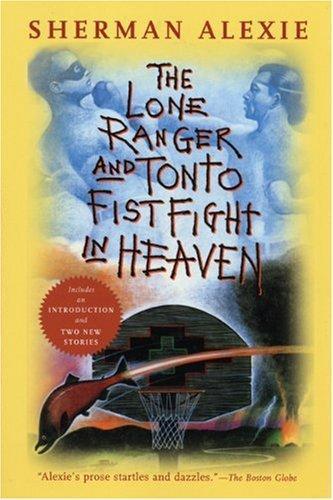English language
The Lone Ranger and Tonto Fistfight in Heaven
The Lone Ranger and Tonto Fistfight in Heaven is a 1993 collection of interconnected short stories by Sherman Alexie. The characters and stories in the book, particularly "This Is What It Means to Say Phoenix, Arizona", provided the basis of Alexie's screenplay for the film Smoke Signals.The collection was originally released in 1993; it was reissued in 2005, with two new stories, by Grove Atlantic Press. The Lone Ranger and Tonto Fistfight in Heaven, published in 1993 by Atlantic Monthly Press, was Sherman Alexie's breakthrough book. Composed of twenty-two interconnected stories with recurring characters, the work is often described by critics as a short-story collection, though some argue that it has novel-like features similar to Louise Erdrich's Love Medicine. The book's central characters, Victor Joseph and Thomas Builds-the-Fire, are two young Native-American men living on the Spokane Indian Reservation, and the stories describe their relationships, desires, and histories with family …
The Lone Ranger and Tonto Fistfight in Heaven is a 1993 collection of interconnected short stories by Sherman Alexie. The characters and stories in the book, particularly "This Is What It Means to Say Phoenix, Arizona", provided the basis of Alexie's screenplay for the film Smoke Signals.The collection was originally released in 1993; it was reissued in 2005, with two new stories, by Grove Atlantic Press. The Lone Ranger and Tonto Fistfight in Heaven, published in 1993 by Atlantic Monthly Press, was Sherman Alexie's breakthrough book. Composed of twenty-two interconnected stories with recurring characters, the work is often described by critics as a short-story collection, though some argue that it has novel-like features similar to Louise Erdrich's Love Medicine. The book's central characters, Victor Joseph and Thomas Builds-the-Fire, are two young Native-American men living on the Spokane Indian Reservation, and the stories describe their relationships, desires, and histories with family members and others who live on the reservation. Alexie fuses surreal imagery, flashbacks, dream sequences, diary entries, and extended poetic passages with his storytelling to create tales that resemble prose poems more than conventional narratives. The book's title is derived from one of the collection's stories, which details the experience of a Native American who leaves the reservation to live in Seattle with his white girlfriend and then moves back. The Lone Ranger and Tonto are symbols for white and Native-American identity, respectively. The names are taken from a popular radio show which first aired in 1933, later leading to a series of books and then a television show in the 1950s in which a white man, the Lone Ranger, teams up with an Indian, Tonto, to battle evil in the old west. Alexie, who claims the title came to him from a dream, studs his stories with other references to popular culture to underscore the ways in which representations of Native Americans have played a part in constructing the image they, and others, now have of them. The book's popularity, in part, stems from James R. Kincaid's effusive praise of Alexie's collection of poetry and stories, The Business of Fancydancing (1992), in The New York Times Book Review. With Kincaid's review, Alexie, who had published with small presses, was thrust into the national spotlight. He deftly depicts the struggles of Native Americans to live in a world that remains hostile to their very survival, and he does so in an honest and artful manner. The Lone Ranger and Tonto Fistfight in Heaven earned a PEN-Hemingway nomination for best first book of fiction.
